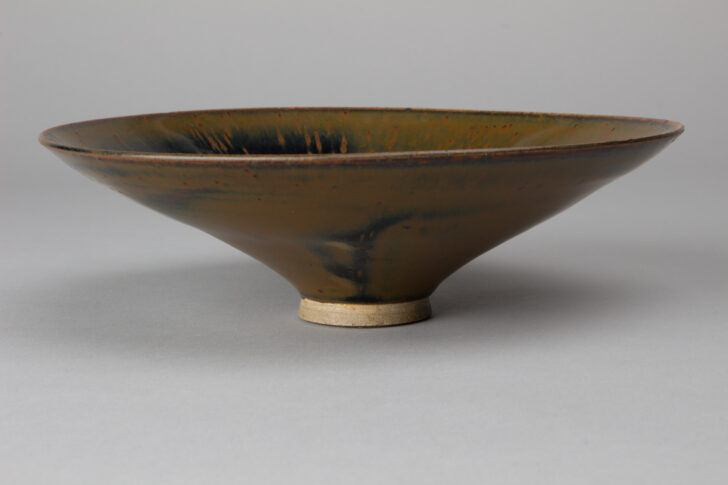Teabowl
Chinese

Description
The Song dynasty (960–1279) in China was a period when the arts of painting, calligraphy, and ceramics reached extraordinary levels of refinement. One of the most celebrated ceramics of the day, produced under the direct supervision of the imperial court, was Ding ware, a creamy white stoneware made at the Ding kiln in northern China and known for its thin walls and elegantly drawn incised designs.
In the early twelfth century, the supremacy of white Ding ware was challenged when a new kind of tea came into favor. No less an authority than Emperor Huizong (r. 1101–25) declared that the black-glazed tea bowls from the Jian kilns of Fujian province in southern China were best for this new tea.
Very soon the Ding kiln began to make iron-glazed black bowl, such as this object, in attempt to compete with the southern Jian kilns. For examples of each type of ware see: white Ding ware (UMMA 1982/1.274), black Jian ware (UMMA 1964/2.8), and black Ding ware (this tea bowl).
No less an authority than Emperor Huizong (r. 1101–25), one of the greatest aesthetes in Chinese history, declared that the dark-glazed tea bowls from the Jian kilns of Fujian in south China were best for tea-drinking. Their thick bodies and black glaze retained heat and showed off the whipped froth of the beverage to advantage. The variegated iridescent glaze of Jian tea bowls was achieved through “controlled accidents” in the kiln and came to acquire aptly descriptive names like “oil spot,” “partridge-feather,” and most famous of all, “hare’s fur “.
Once black bowls became fashionable for tea in the early twelfth century, other kilns, even those best known for white wares, like the Ding kilns of north China, began to make bowls with dark glazes. The glazed surface of tautly-shaped and thinly-potted black Ding tea bowls was usually mat and plain, evoking the appearance of expensive black lacquer. The streaky russet- brown glaze applied over a previous glaze of shiny green-black on this Ding tea bowl is perhaps an attempt to outdo the sought-after “hare’s fur” glaze of Jian bowls.
(Label for UMMA Chinese Gallery Opening Rotation, March 2009)
Subject Matter:
A rare black ding ware tea bowl with a partridge feather mottle (鷓鴣斑 zhegu ban) for elaborate tea drinking events among scholars and elite of the Northern Song (960-1127) to Southern Song dynasties (1127-1279).
The Song dynasty (960–1279) in China was a period when the arts of painting, calligraphy, and ceramics reached extraordinary levels of refinement. One of the most celebrated ceramics of the day, produced under the direct supervision of the imperial court, was Ding ware, a creamy white stoneware made at the Ding kiln in northern China and known for its thin walls and elegantly drawn incised designs.
In the early twelfth century, the supremacy of white Ding ware was challenged when a new kind of tea came into favor. No less an authority than Emperor Huizong (r. 1101–25), one of the greatest aesthetes in Chinese history, declared that the black-glazed tea bowls from the Jian kilns of Fujian province in southern China were best for this new tea. Very soon the Ding kiln began to make iron-glazed black bowls, such as this object, in attempt to compete with the southern Jian kilns. For examples of each type of ware see: white Ding ware (UMMA 1982/1.274), black Jian ware (UMMA 1964/2.8), and black Ding ware (this tea bowl).
Emperor Huizong declared that the dark-glazed tea bowls from the Jian kilns of Fujian in south China were best for tea-drinking. Their thick bodies and black glaze retained heat and showed off the whipped froth of the beverage to advantage. The variegated, iridescent glaze of Jian tea bowls was achieved through “controlled accidents” in the kiln and came to acquire aptly descriptive names like “oil spot,” “partridge-feather,” and most famous of all, “hare’s fur “.
Once black bowls became fashionable for tea in the early twelfth century, other kilns, even those best known for white wares, like the Ding kilns of north China, began to make bowls with dark glazes. The glazed surface of tautly-shaped and thinly-potted black Ding tea bowls was usually mat and plain, evoking the appearance of expensive black lacquer. The streaky russet-brown glaze applied over a previous glaze of shiny green-black on this Ding tea bowl is perhaps an attempt to outdo the sought-after “hare’s fur” glaze of Jian bowls.
Physical Description:
A conical, wide-flaring buff stoneware teabowl with a direct rim on a straight footring, covered with black glaze with russet brown mottling on the exterior and russet streaks on the interior.
Usage Rights:
If you are interested in using an image for a publication, please visit https://umma.umich.edu/request-image/ for more information and to fill out the online Image Rights and Reproductions Request Form.